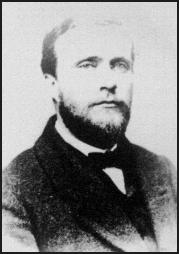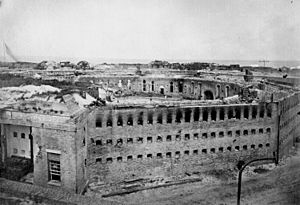Miles D. McAlester facts for kids
Quick facts for kids
Miles Daniel McAlester
|
|
|---|---|

Miles Daniel McAlester
|
|
| Born | March 21, 1833 Belfast, New York |
| Died | April 23, 1869 (aged 36) Buffalo, New York |
| Place of burial |
Hollenback Cemetery
Wilkes-Barre, Pennsylvania |
| Allegiance | Union |
| Service/ |
Union Army |
| Years of service | 1856–1869 |
| Rank | |
| Battles/wars | American Civil War |
Miles Daniel McAlester (born March 21, 1833 – died April 23, 1869) was an important officer in the United States Army. He served as a Major in the Union Army during the American Civil War. Later, he was recognized for his bravery and skill. He was given the special rank of brevet brigadier general. This means he earned the rank for his actions, even though he wasn't officially promoted to it in the regular army at that time.
Contents
Early Life and Army Training
Miles Daniel McAlester was born in a town called Belfast, New York. He loved learning and joined the United States Military Academy at West Point in July 1852. This is a famous school where people train to become army officers.
He worked very hard and graduated four years later. He was one of the top students in his class, ranking third out of 49 cadets. After graduating, he became a second lieutenant in the Army Engineers. This was a highly respected job.
Civil War Service and Key Roles
When the American Civil War began in April 1861, McAlester played a big role. He became the main engineer for the Defenses of Washington, D.C.. This meant he helped design and build forts to protect the capital city.
In May 1861, he was promoted to first lieutenant. His skills were very important during the war.
Engineering the Peninsula Campaign
From April to July 1862, McAlester worked as the chief engineer for the Army of the Potomac's III Corps. This army group was involved in the Peninsula Campaign. During this campaign, McAlester showed great courage and skill.
He was recognized twice for his excellent work. He earned special promotions, called brevets, to major and then to lieutenant colonel. These special ranks showed how valuable his engineering work was.
Leading Engineers in the West
After the Peninsula Campaign, McAlester continued his important work. He was the lead engineer for the Department of Ohio. Then, he joined the Army of the Tennessee. He helped plan and build defenses for these armies.
In March 1863, he was promoted to captain in the regular army. He also became the lead engineer for the Defenses of Cincinnati. Later, he moved to the Department of the Gulf. Here, he helped with military operations in the southern United States.
Battles in Alabama
McAlester was in Alabama during some major battles in August 1864. He helped with the sieges of Fort Gaines and Fort Morgan. For his brave actions in these battles, he was given another brevet promotion to colonel.
His most notable achievement came during the Battle of Fort Blakeley in April 1865. This battle was part of the fight to capture Mobile. For his outstanding conduct, he was nominated for the rank of brevet brigadier general. This nomination was approved by President Andrew Johnson and the United States Senate.
After the War
After the Civil War ended, Miles McAlester decided to stay in the army. He continued his career, even though the army became much smaller in peacetime.
He was promoted to major in March 1867. Miles Daniel McAlester passed away in Buffalo, New York in 1869. He was buried in Hollenback Cemetery in Wilkes-Barre, Pennsylvania.
Engineer's Detailed Plans
During his time in the Civil War, McAlester created many detailed maps. These maps showed the defenses of the Confederate army. They were very helpful for the Union forces.
Two of his plans show the defenses of Fort Blakely in Mobile, Alabama, from 1865. These plans were later published in the official records of the Civil War.
The first image shows seven plans for forts and redans (small forts) that led to Fort Blakely. The second image shows the four main defenses in the area around the fort. These plans highlight McAlester's skill as a military engineer.





